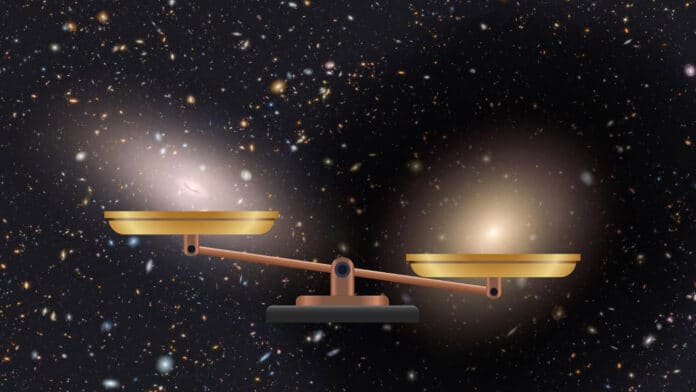According to the Λ cold dark matter (ΛCDM) cosmology, present-day galaxies with stellar masses should contain a sizable fraction of dark matter within their stellar body. Models indicate that in massive early-type galaxies (ETGs), dark matter should account for ∼15% of the dynamical mass.
The University of La Laguna (ULL) and the Instituto de Astrofsica de Canarias (IAC), under the direction of international research, have discovered the first indication of a large galaxy devoid of dark matter. The outcome poses a problem for the presently accepted cosmological paradigm.
The galaxy NGC 1277 does not contain dark matter, according to a team of scientists led by Sebastián Comerón, a researcher at the IAC and the University of La Laguna (ULL). This is the first instance of a huge galaxy (whose mass is several times greater than the Milky Way‘s) failing to exhibit signs of this unobservable aspect of the cosmos.
NGC 1277 is regarded as a “relic galaxy” prototype, which refers to a galaxy that has never interacted with its neighbors. These galaxies are extremely uncommon and are considered the remains of massive galaxies that first formed in the early universe.
University of La Laguna (ULL) Sebastién Comerón said, “The importance of relic galaxies in helping us understand how the first galaxies formed was why we decided to observe NGC 1277 with an integral field spectrograph. From the spectra, we made kinematic maps which enabled us to work out the distribution of mass within the galaxy to a radius of some 20,000 light years.”
Although the data are compatible with the absence of any dark matter, the scientists found that the mass distribution in NGC 1277 was simply the distribution of the stars. From this, they deduced that there cannot be more than 5% of dark matter present within the measured radius.
Ignacio Trujillo, a researcher at the IAC and the ULL who participated in the study, said, “However, present cosmological models predict that a galaxy with the mass of NGC 1277 should have at least 10 % of their mass in the form of dark matter, with a maximum of 70 % in this form. “This discrepancy between the observations and what we would expect is a puzzle, and maybe even a challenge for the standard model.”
Anna Ferré-Mateu, a researcher at the IAC and the ULL who also participated in the study, said, “The article suggests two possible explanations for the lack of dark matter in NGC 1277. One is that the gravitational interaction with the surrounding medium within the galaxy cluster in which this galaxy is situated has stripped out the dark matter. The other is that the dark matter was driven out of the system when the galaxy formed by merging protogalactic fragments, which gave rise to the relic galaxy.”
Comerón said, “For the study’s authors, neither of these explanations is fully satisfactory, so the puzzle of how a massive galaxy can form without dark matter remains a puzzle.”
If the conclusion that NGC 1277 lacks dark matter is confirmed, it would seriously undermine theories that gravity is altered and that most gravitational attraction within galaxies is caused by a minute modification to the law of gravity on large scales.
Journal Reference:
- Comerón, Sébastien, et al.: The massive relic galaxy NGC 1277 is dark matter deficient. From dynamical models of integral-field stellar kinematics out to five effective radii, A&A 675, A143 (2023) DOI: 10.1051/0004-6361/202346291
